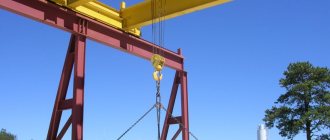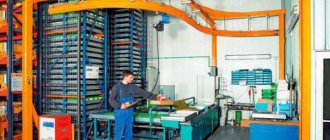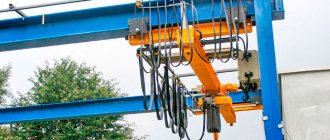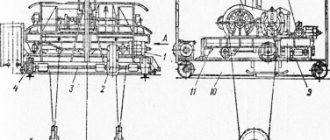Useful tips
Who is a technical equipment engineer and what are his responsibilities is a question that interests many people. This is a person with a higher engineering education and special knowledge. At production enterprises he has the right:
- give tasks to subordinates;
- control their implementation;
- request necessary technical documents;
- contribute ideas to improve the organization’s work;
- demand the creation of comfortable working conditions for subordinates.
He is responsible for failure to fulfill duties, violation of labor regulations, and appearance at the workplace while intoxicated.
If you need to have a duplicate of the passport or instructions, you need to order them from the equipment manufacturer. They can also be obtained from specialized enterprises, which must first carry out a full technical diagnosis of the crane.
To carry out PHT of crane devices, it is recommended to prepare in advance a set of loads participating in the tests. Each load must be marked with its weight. During testing, the presence of someone responsible for the condition of the lifts is mandatory.
Regulations on VET in construction, rights and obligations of VET (download)
You can download the position of the production and technical department in .doc format for review or implementation in your company. This format will allow you to edit the position to suit your field of activity.
Download the PTO regulations
The most important document management tasks are entrusted to engineers, who have to draw up complex documentation, carry out calculations, generate estimates and provide their transcripts, and participate in negotiations. They are also entrusted with the function of monitoring the production process and execution of installation work. That is why the most stringent requirements are imposed on the professionalism of these people.
Technical examination of lifting structures
For all lifting structures specified in clause 3 of the FNP PS (both those registered with Rostechnadzor and those not subject to registration with Rostechnadzor) it is necessary to carry out a technical examination.
a load-lifting cranes of all types;
b overhead stacker cranes;
in pipe-laying cranes;
g cranes;
d construction lifts;
e lifts (towers) designed to move people, people and cargo (lifts with working platforms);
g electric freight trolleys moving along elevated rail tracks together with a control cabin;
h electric hoists;
and excavator cranes designed to work with a hook;
to replaceable load-handling devices and removable load-handling devices (hooks, grabs, magnets, spreaders, traverses, grippers, slings), used in conjunction with the PS for lifting and moving loads;
l containers for transporting goods, with the exception of special containers used in metallurgical production (ladles, molds), as well as special containers used in sea and river ports;
m special removable cabins and cradles, hung on the load-handling parts of cranes and used for lifting and moving people;
n rail tracks (for supporting and suspended substations moving on rails).
Scope of work, procedure and frequency of technical examination:
Lifting structures must undergo technical inspection before they are put into operation, as well as during operation. The scope of work, the procedure and frequency of technical examinations are determined by the manual (instructions) for the operation of the substation. A similar amount of work is performed during extraordinary technical examinations in cases established by the Federal Tax Service.
The static test is carried out by loading the lifting structure at 25% greater than the rated load capacity.
Dynamic testing of a lifting structure is carried out with a load 10% greater than the rated load capacity.
The purpose of the static test is to check the strength of metal structures and mechanisms of the substation. During dynamic testing, the operation of mechanisms and brakes is checked.
Purpose of truck cranes
Vehicles are used as loading and unloading or construction vehicles. This equipment is often applicable:
- to capture a selected specific design;
- releasing or uncoupling;
- lifting and carrying;
- setting to the initial position.
Operations are cyclical after a specified time. The purpose of truck cranes is to perform certain actions to move a large amount of cargo put on stream. Cranes are divided into certain groups. The use of self-propelled cranes is not accidental here, since their equipment is characterized by modern replaceable equipment. This allows the vehicle to be used under any conditions.
Instant change of operating mode parameters is possible. There is greater maneuverability in small areas. Using a self-propelled crane will save money and prepare the area according to the customer’s instructions. Moving a vehicle between objects is made easier.
Jib cranes can be truck-mounted, pneumatic-wheeled, or crawler-mounted, specially adapted to work in tight conditions. Self-propelled cranes are suitable for lifting or moving goods over short distances on construction sites.
Special vehicle-type platforms are designed for truck cranes. Main features of the equipment:
- excellent maneuverability in any territory;
- instant assembly or disassembly in prepared areas;
- the presence of interchangeable components;
- minimum dimensions;
- the presence of a full speed limit for quick movement around the city;
- control of equipment by one person.
Areas of use of truck cranes:
- installation of walls or other volumetric structures;
- laying pipelines and technical communications;
- loading or unloading in an area with a minimum area;
- road and utility works;
- modernization of bridges;
- working away from the planned location;
- work on disconnected objects.
The most popular brands are:
- Liebherr;
- XCMG to determine the use of IT technologies;
- Grove;
- Tarex-Demag.
All truck cranes undergo serious inspections annually. Russian brands are less popular, so customers prefer the above models. All modern equipment is equipped with controlled devices for truck cranes, which significantly increase the performance of the product.
How to install a sign on a truck crane
In material warehouses and other work areas, warehouse managers and foremen may be appointed as persons responsible for the safe performance of work by cranes, in agreement with Rostechnadzor authorities. Rice. 4.1. Supervision structure for the safe operation of cranes Responsibility for ensuring the safe operation of cranes in each work area during each shift should be assigned to only one employee. The names of these persons must be indicated on a sign posted at the permanent work site
ATTENTION! The person responsible for the safe performance of work with cranes is the immediate supervisor of the slinger
Technical examination of cranes (PT)
Federal Law No. 116 “On Industrial Safety of Hazardous Production Facilities”. The examination includes a set of measures to check the condition of technical documentation, organize a service for the safe operation of a hazardous production facility, and assess the technical condition of equipment. Based on the results of the examination, a conclusion is issued containing an expert assessment of the condition of the lifting mechanism and design documentation. When is an industrial safety review carried out?
- Expiration of the service life of the PMG on a periodic basis
- Lack of design documentation
- After reconstruction, modernization
- After an emergency occurs
- Change of owner of a lifting structure
- As prescribed by Rostekhnadzor
Industrial safety examinations are carried out by expert organizations licensed by Rostechnadzor.
Who carries out the inspection of the crane beam (what, what)?
A steel rope is a twist of strands consisting of wires and having a core. Core material: a).organic core (OC) – used for cold loads. b).metal core (M.C.) - used for cold and hot loads. c).asbestos core (A.C.) – used for cold loads and at a certain t. d).artificial core (I.S.) - used for cold loads. The purpose of the core is to give the rope its shape, and some also serve to lubricate and make the rope flexible (O.S. and I.S.). For the manufacture of slings, cross lay ropes are used, since they belong to the group of low-twisting ropes - this is when the directions of the strands and wires in the strands are opposite. For slings, round-shaped ropes are used.
Important Technical characteristics and operating instructions for the KrAZ-260 military truck
The structure of the TVET department and the organization as a whole.
The organizational structure is a conceptual model of the correct organization of work; coherence in the operational solution of certain tasks depends on it.
Each VET specialist can be conditionally classified into one of 3 categories:
- Group for preparing documents at the tender stage. The preparatory work before the conclusion of the contract rests on her shoulders.
- Estimate and contractual group (pricing department) The employees included in it draw up and analyze estimates, provide their transcripts to company managers, draw up and check contracts before signing, conduct and draw up factor analyzes and other financial documents.
- Production and technical group. They develop PPR, permitting and executive documentation, maintain and control the document flow from the beginning until the end of construction.
Frequency of lifting structures
Partial technical inspection is carried out at least once a year. In this case, the facility manager can establish a lower frequency by local act. Also, recommendations for carrying out activities that are more often regulated by law can be given by the equipment manufacturer, indicating the reasons that caused such a need.
What work is included in WHAT
Partial technical inspection of lifting structures is carried out by visual inspection of all its parts, including components of the lifting mechanism, crane tracks, and hoist beams. The mechanism for lifting loads without load is also tested, the serviceability of the brake system, the condition of the stairs and the operator’s work area are checked. The documentation on the mechanism must be checked.
Frequency of maintenance of lifting structures
A complete technical inspection of lifting structures is carried out at least once every three years. In addition, such a check must take place after major repair work has been carried out, as well as after the facility has been put into operation after conservation.
What work is included in technical training?
Carrying out a full technical inspection of a lifting structure takes place in several stages:
- Visual inspection of all mechanisms and components of the structure;
- Static tests to determine strength;
- Dynamic tests to check the performance of the lifting mechanism and other systems of the lifting structure.
These tests are carried out according to special methods provided for each type of lifting structures used in industry.
Survey and examination
Scope of work during a partial technical examination (WHAT):
Conducting a partial inspection of cranes includes a comprehensive check of the condition of the equipment and equipment of the machine, technical documentation and inspection of metal structures:
During the process the following are checked:
- Electrical equipment and condition of cable products
- Brake systems
- Safety devices
- Condition of metal structures
- Compliance of crane tracks with safety rules, availability of grounding of crane tracks
- Rope-block system, condition of ropes, attachment points
- Availability of technical documentation (crane passport, crane track, comprehensive inspection, maintenance)
- Organization of a safe operation service for the facility, availability of responsible specialists
An organization that uses lifting structures in its activities is obliged to conduct a partial technical examination at least once every 12 months.
A full technical inspection (FTE) includes all the work included in the WHAT, plus:
- Static tests (carried out with a load exceeding the crane’s lifting capacity by 25%)
- Dynamic tests (carried out with a load exceeding the crane’s lifting capacity by 10%)
Who carries out the technical inspection?
Technical inspection work must be carried out by engineering and technical personnel of the organization operating lifting mechanisms, certified in knowledge of industrial safety requirements and having sufficient experience in working with lifting structures. If these specialists are not available on the organization’s staff, the work is carried out by specialists from the specialized organization ProjectKranMontazh.
A set of documentation based on the results of the technical examination:
Based on the results of technical inspection work, the following documentation is provided:
- Static test results report
- Report on the results of dynamic tests
- Certificate of full technical examination (PTO) or partial technical examination (PTO) or List of defects identified during the examination
Comprehensive examination
A comprehensive inspection of the track is mandatory in accordance with the requirements of industrial safety rules; work on a comprehensive inspection is carried out by specialized expert organizations that have the appropriate license to perform work of this type.
The frequency of a comprehensive examination is at least once every 3 years. In the intervals between inspection work, at least once a year, the owner of the lifting structure must ensure that the crane tracks are leveled to control the horizontal position and ensure safe operating conditions.
In the absence of proper fastening of the guides, or the presence of deviations exceeding permissible standards, there is a possibility of an emergency situation, a threat to the life and health of operating personnel.
In the event of an emergency equipment failure, unexpected equipment downtime occurs, which inevitably entails economic losses in production.
During the comprehensive survey work, they are checked.
- Availability of an organized service for operating the lifting structure
- Technical and operational documentation
- Planned-altitude survey and inspection of crane track elements is carried out
- Guides (rail, square, I-beam)
- Butt and intermediate fastenings
- Dead-end stops, limiters, guards, warning signs, grounding
- Metal structures and their fastening units
A set of documentation based on the results of a comprehensive survey:
Based on the results of technical inspection work, the following documentation is provided:
- Certificate of comprehensive inspection of the crane runway
- List of defects based on the results of the inspection (if any)
- Plan-height survey of crane track elements
Useful tips
Who is a technical equipment engineer and what are his responsibilities is a question that interests many people. This is a person with a higher engineering education and special knowledge. At production enterprises he has the right:
- give tasks to subordinates;
- control their implementation;
- request necessary technical documents;
- contribute ideas to improve the organization’s work;
- demand the creation of comfortable working conditions for subordinates.
https://youtube.com/watch?v=sqx5Ud9C1u4
He is responsible for failure to fulfill duties, violation of labor regulations, and appearance at the workplace while intoxicated.
If you need to have a duplicate of the passport or instructions, you need to order them from the equipment manufacturer. They can also be obtained from specialized enterprises, which must first carry out a full technical diagnosis of the crane.
To carry out PHT of crane devices, it is recommended to prepare in advance a set of loads participating in the tests. Each load must be marked with its weight. During testing, the presence of someone responsible for the condition of the lifts is mandatory.
conclusions
Alexander
Ask a Question
The production and technical department is one of the most important departments of a construction enterprise, since it is here that most of the documentation required at each stage of construction of the facility is analyzed and completed. The VET is headed by a technical director, who at the same time can have the status of chief engineer in the organization. It follows that all employees of the department must be highly qualified professionals with higher education in their direct specialty. Compliance with this principle will increase the efficiency of the enterprise as a whole. I'll be glad to answer your questions!
Fines for non-compliance with legislation on carrying out technical and technical training
Failure to carry out timely technical inspection of lifting structures will result in a fine under Part 1 of Art. 9.1 of the Code of Administrative Offenses of the Russian Federation, which provides for liability for non-compliance with industrial safety requirements. For legal entities, the fine ranges from 200 to 300 thousand rubles, for officials - from 20 to 30 thousand rubles. Also, the activities of the organization can be suspended for up to 90 days, and the official can be disqualified for a period of six months to a year.
With respect to you and your business,
legal
2012 - 2022, Legal, TIN 7801575758, OGRN 1127847299645. All rights reserved. Copying site materials is prohibited by law. Any information about services and promotions posted on this website is not a public offer (clause 2, article 437 of the Civil Code of the Russian Federation).
Moscow, St. Petersburg, Tyumen, Murmansk, Nazran, Vladivostok, Voronezh, Yekaterinburg, Irkutsk, Kaliningrad, Kemerovo, Krasnodar, Kursk, Novosibirsk, Novy Urengoy, Orel, Petrozavodsk, Rostov-on-Don, Samara, Stavropol, Surgut, Syktyvkar , Tomsk, Ufa, Khabarovsk, Khanty-Mansiysk, Yuzhno-Sakhalinsk, Yakutsk.
By leaving your data, you agree to the terms of the User Agreement and consent to the processing of personal data.
What is being inspected?
Technical examination of a tower crane involves establishing the operability of all its equipment and mechanisms
Important Design features and characteristics of the KB-403 rail-mounted tower crane
Close attention is paid to inspecting the metal structure of the device, its welded connections are examined, as well as how firmly the fastening of the cabin, fences and stairs, and other structures that are used by workers to move
In addition, the PS tests:
- Hook, as well as other devices for gripping cargo for wear resistance;
- Rope fastenings;
- Blocks, axles and fastening units;
- Grounding condition;
- Ballast to counterweight ratio, compliance with established standards;
- Crane tracks for their operability and proper condition.
Classification of truck cranes
The design is actively used for the construction of relatively different preparations. Tower cranes have telescopic booms and high-rigidity suspensions. Equipment stability is possible due to outriggers and stabilizers that can turn off the rear axle springs.
Truck cranes are distinguished by lifting capacity and type of used drive mechanisms used on replaceable equipment. The proposed characteristics comply with GOST. Cranes are divided into light, medium and heavy. Based on the use of the drive, equipment is classified into mechanical, electrical, and hydraulic types. If it is necessary to use certain replaceable equipment, then cranes are divided into general purpose vehicles or semi-universal ones.
Purpose of the event
During the inspection, tests are carried out on the main parts of the crane. Tests can be static or dynamic. Their goal is to check the quality of the following systems:
- safety devices;
- control systems;
- brakes;
- alarms;
- lighting;
- hooks and other load support parts;
- ropes;
- blocks;
- boom design and its fastening;
- paths of movement of the device;
- other systems.
Inspection of cranes during static tests includes:
- checking load capacity;
- inspection of the boom structure and lifting mechanism along with the ropes.
The purpose of dynamic testing is to check the brakes. The results of all tests are entered into the crane's passport. The date of the next survey is indicated.
PTO, THAT of cranes - Diagnostics, PTO and THAT of cranes, towers. EFI. Development of TC.
Full and partial inspection of the crane
Any equipment, including load-lifting cranes, must have a personal instruction manual, based on which regular maintenance is carried out (Resolution of the Ministry of Emergency Situations of the Republic of Belarus dated May 15, 2015 No. 23). This condition is necessary so that during the inspection process it can be reliably determined whether the PMG is in working order, how reliable and safe it is for operation. Maintenance also includes an inspection of the load-lifting crane for its correct, accurate installation in compliance with all parameters.
There are several types of technical examination of equipment:
- complete (PTO),
- partial (WHAT).
As a standard, this is carried out once a year, however, after reconnecting or replacing the ropes, a partial inspection is carried out again in order to determine the reliability of the fastenings.
Technical maintenance is carried out once every three years, as well as at the initial stage before the introduction of lifting equipment into operation.
Important! If the crane is not used constantly, then it is classified as rarely used (in agreement with Gospromnadzor). Technical maintenance of such equipment should be carried out once every five years
In the event of an unscheduled replacement of components, load-bearing elements, restoration, renovation and repair, the need for unscheduled maintenance may arise.
During a full technical inspection of cranes, static and dynamic tests are carried out - this is its main difference from a partial inspection.
What is included in the static testing of lifting equipment?
The PMG is installed in such a way that the bridge is bent as much as possible. In this position, the crane must lift a special load (25% heavier than normal) and hold it for 10 minutes. After the procedure, specialists check the bridge and, if defects are found, the crane will not be allowed to operate until the causes of the deformation are identified.
What is included in the dynamic testing of lifting equipment?
Dynamic means movement. Therefore, the basic requirements for installing the crane remain the same (the load is 10% heavier than normal), but the lifting and lowering of the load is done 3-4 times. The purpose of this test is to check the serviceability of the lifting mechanism and its brakes.
Important! All necessary components (test weights, etc.) for performing test work are provided by the owner of the lifting equipment
The specialist performing the control records the results of maintenance and the date of the next inspection in the technical passport of the crane. The entry made must confirm that the gas turbine unit meets all operating requirements, has passed the tests and is in good condition.
Files for download:
| Rules for ensuring the safety of cranes (.pdf) | Download | 281.13 KB |
Types of truck cranes by boom length
All forklifts are divided into types according to boom length. In order to achieve versatility and multifunctionality, manufacturers try to achieve the maximum boom reach when designing.
A truck crane is a machine that can be used in other areas. The length of the booms and the load capacity are not directly dependent characteristics of the equipment. But the increase in tonnage also increases the characteristics of the boom range:
- the boom reaches up to 14 m with a lifting capacity of 14 tons;
- 18-21 m boom size at 18-21 t;
- 28-47 meters boom at 25 tons;
- 34-48 m at 50 t;
- The boom reaches 52-71 m for 90-100 ton vehicles;
- 56-100 m for special equipment with a tonnage of 120 tons or more.
Also, truck cranes can be divided into two groups according to the type of cabin: with a stationary cabin and a non-fixed one. The non-fixed cabin comes in different designs: hydraulic and rotating.
Types of truck cranes vary, but the stationary cabin of special equipment does not move, but has panoramic glazing. Also, automobile cranes are divided into types according to the type of working mechanism. During operation, passing the technical and technical inspection of the truck crane is necessary for safety.
Purpose of the event
During the inspection, tests are carried out on the main parts of the crane. Tests can be static or dynamic. Their goal is to check the quality of the following systems:
- safety devices;
- control systems;
- brakes;
- alarms;
- lighting;
- hooks and other load support parts;
- ropes;
- blocks;
- boom design and its fastening;
- paths of movement of the device;
- other systems.
Inspection of cranes during static tests includes:
- checking load capacity;
- inspection of the boom structure and lifting mechanism along with the ropes.
The purpose of dynamic testing is to check the brakes. The results of all tests are entered into the crane's passport. The date of the next survey is indicated.










